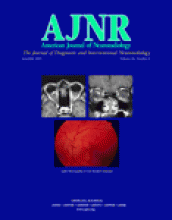The article “Iron Particles Enhance Visualization of Experimental Gliomas by High-Resolution Sonography,” which appears in this issue of the AJNR, focuses on a potential new use of contrast enhanced ultrasonography (US) with iron oxide–based contrast agents in brain tumors. Our laboratory, for instance, has used MR imaging and histologic studies to image iron particles that target inflammation in the CNS such as in brain tumors (1–4). In the current report, the authors used iron oxide particles to enhance sonography imaging.
More specifically, a brain tumor model (surgical inoculation of C6 glioma) was used. Three groups with 12 rats each were studied: (1) gadolinium diethylene triamine pentaacetic acid contrast; (2) superparamagnetic iron (IO) 24 hours before scanning; and (3) no contrast. An MR imaging study was obtained 11 days after tumor inoculation in the 36 animals. Immediately after scanning, the brains were extracted and placed in saline for US. Subsequently the tissue was observed histologically by using different stains to detect tumor, iron particles, and macrophages. The authors conclude that IO contrast improves tumor definition with IO-enhanced US.
The authors present an interesting and new application for IO in neurosurgery. Cavernous angiomas are a good clinical example of how a tumor that contains iron particles as part of the lesion may look like with intraoperative US. These lesions are characteristically encased in hemosiderin (granular brown deposits of ferric oxide) and gliotic tissue. They are very hyperechoic and, hence, easily localizable with US, even if they are deeply located (5, 6). Surgeons have found US extremely useful and reliable when operating on these lesions, to an extent that it can be more helpful than intraoperative MR and other neuronavigational tools.
Another possibility is that IO-enhanced US can be helpful in cases of carotid stenosis. IOs are phagocytized by reticuloendothelial cells, and these cells are important in ulcerated plaques. These particles may be able to localize the inflammatory process involved in atheroesclerotic disease, because the IO particles target inflammatory cells. Such labeled cells could influence therapy of this disease by focusing more on the inflammation rather than the plaque itself.
Intraoperative US has several advantages over other neurosurgical guidance systems such as intraoperative MR scanners and neuronavigators. US is practical and reliable, less expensive, and available in most centers around the world. The information is obtained immediately and in real time (therefore brain shift is not an issue, as it is with MR imaging). Sonography can be enhanced with the use of IO contrast in tumors, as the authors illustrate. One limitation of the study is that it was done on extracted brains rather than live animals.
Overall, the article presents an attractive idea that is worth pursuing in clinical settings of tumor and/or inflammatory lesions.
- Copyright © American Society of Neuroradiology












